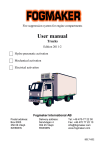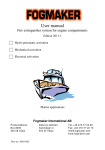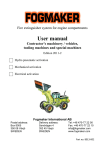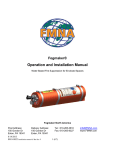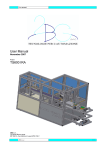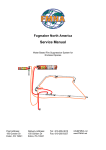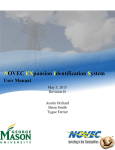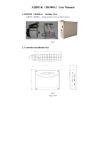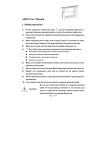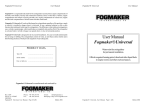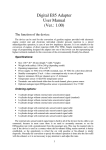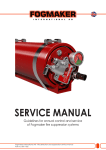Download Bus driver manual ENG
Transcript
BUS DRIVER MANUAL www.fogmaker.com Edition 2.1 Art. No. 8012-002 Overview This manual is aimed at the bus driver and other users and should be placed avaliable in the driver area. This manual describes Fogmaker’s fire extinguisher system for closed engine departments. Fogmaker’s fire extinguisher system’s main parts www.fogmaker.com 2 Edition 2.1 Content General description Pertaining components 4 4 Pertaining components Extinguisher cylinder Release valve for extinguisher cylinder Detector cylinder Novec system 4 6 7 8 8 Alarm test 9 Alarm test with Fogmaker bus alarm Alarm test in an existing alarm system - multiplexer 9 9 In the event of fire 9 Fire alarm signal with Fogmaker bus alarm Fire alarm signal in existing alarm system - multiplexer 9 9 Low pressure alarm 10 In the event of a smoke alarm 10 Fogmaker alarm Existing alarm system - multiplexer 10 10 Action after a fire Daily inspection of the extinguisher system Annual controls 5 year service and 10 year overhaul 10 11 11 11 General description Pertaining components This bus is equipped with a fully automatic extinguisher system for the engine compartment and possible separate heating areas. The system is activated hydro-pneumatically and works without any power supply. When extinguishing the extinguishant is sprayed through nozzles that break down the fluid into pillar-shaped mist clouds that cool the temperature and force the air out. The extinguishant is mainly based on antifreeze water. The extinguishing time is normally between 3-5 seconds and the effective time is 50-75 seconds. Pertaining components This system consists of: • the extinguisher cylinder (1) • the detection cylinder (2) • pipe system with nozzles (3) • detector hose of polymer connected between the detection cylinder and the extinguisher cylinder (4) • Fogmaker alarm lamp and alarm buzzer with light and sound alarm, alternatively existing bus-specific alarm panel (5) Overview of components and how they schematically are connected www.fogmaker.com 4 Edition 2.1 The detector hose and the nozzles are located in the upper part of the engine compartment and if applicable heating areas. The extinguisher cylinder and the detector cylinder are located in a separate area. The smoke alarm is located in the ceiling in the passenger compartment. Fogmaker’s alarm lamps and alarm sirens are located in the driver’s position. For alarms integrated in an existing bus system e.g., CAN bus – multiplexer, see the bus manufacturer’s manual for the location. In the event of fire the detector hose bursts. When the pressure drop in the detection system has fallen to approx 7 bars a valve on the extinguisher cylinder is activated and the system is released. The pressure switch on the detector cylinder sends an alarm to the driver position. As an option there is also a manual and an electric punch that is mounted on the detector hose. With the help of this the driver can manually trigger the system by cutting off the detector hose. Overview of components and where in a bus they are situated, variations do occur www.fogmaker.com 5 Edition 2.1 Extinguisher cylinder On delivery the extinguisher cylinder is filled to approx 105 bars pressure. The propellant consists of nitrogen gas. The pressure can be read off on manometer and shall be within the green sector. The extinguisher cylinder is also available in a version with two or three connected cylinders. As an option there is a pressure switch that gives an alarm if the pressure falls below approx 80 bars, the same alarm as for a fire. On the release valve a Information decal Art No 8100 seen on the extinguisher cilynder Extinguisher cylinder top view with new release valve - see opposing side. www.fogmaker.com 6 Edition 2.1 Release valve for extinguisher cylinder The release valve has a safety screw that should be removed when the system is active. There are two different types of release valves; one older where the safety screw is mounted from the top. This should be removed to activate the extinguisher. The newer valve has the safety screw mounted from the side. The safety screw is red and should be removed to activate the system. A green, (shorter) cover screw shall then be mounted to prevent dirt from entering the release valve. New release valve The safety screw shall always be mounted before service, installation and transport when the extinguisher cylinder is pressurized. The safety screw prevents unintentional release of the extinguishant. It is absolutely forbidden for non-authorized personnel to take any action on the extinguisher cylinder when it is pressurized. The pressure in the cylinder can then be released and can with great power injure a person seriously. Old release valve www.fogmaker.com 7 Edition 2.1 Detector cylinder Novec system On delivery the detector cylinder is filled with detector fluid and pressurised with nitrogen gas to approximately 24 bars. The pressure can be read off on a manometer and shall be in the green sector. The detector cylinder is equipped with one or two (optional) pressure switches that send an alarm if the pressure falls below 14 bar respectively 7 bar (optional) . The detector cylinder has a tap that shall be open when the system is active. In some cases, a gas extinguisher system called Novec 1230 is installed in the heater area in the bus. This system has an identical detector cylinder as the standard detector system, a decal shows this is a Novec system. The Novec system basic function is a gas filled detector tube that breaks at a fire and releases the extinguishing agent. The Novec cylinder is equipped with manometer and a pressure switch that is connected to the same alarm as the standard fire extinguisher system. Pressure switch 14 bars (standard) Manometer Tap (open position) Pressure switch 5 bars (option) Detector cylinder, top view, with two pressure switches and a standard L-connection after the tap. www.fogmaker.com 8 Edition 2.1 Alarm test In the event of fire • • • • Shut down engine Evacuate vehicle Cut off power supply Keep engine bonnet closed at least for 5 minutes • If needed, use hand fire extinguisher • Contact service personnell The fire alarm shall be tested before the work period commences. Alarm test with Fogmaker bus alarm • Press the test button with the engine fire lamp. Fire alarm signal with Fogmaker bus alarm In the event of a fire the red lamp marked with engine fire is flashing and the alarm siren gives an intermittent sound. check the 1747 (Older model): When the test button is pressed the engine fire lamp shall flash and an intermittent alarm sound shall be heard in the driver position. 1747-020-00 (New model): When the test button is pressed the engine fire lamp shall be constant lit and a constant alarm sound shall be heard in the driver position. If no fire has occurred and the system has not been triggered it indicates that there is too low a pressure in the extinguisher cylinder or the detector cylinder. Contact service personnel. Alarm test in an existing alarm system multiplexer Fire alarm signal in existing alarm system multiplexer See the bus manufacturer’s manual for alarm test. See the bus manufacturer’s manual for alarm signals in fire alarms. www.fogmaker.com 9 Edition 2.1 Low pressure alarm Action after a fire In the event of an alarm for low pressure in the detector cylinder or extinguisher cylinder, contact service personnel. The fire alarm will sound until the alarm is actively shut off. This is done by contacting authorized service personnel. For systems with the Fogmaker bus alarm the alarm signal can be shut off by removing the cover of the pressure switch on the detector cylinder and the two electrical cables are twined together. In the event of a smoke alarm Do not start the vehicle before the cause of fire has been established and corrected. Fogmaker alarm In the event of a smoke alarm the lamp on the sign, ”Smoke alarm upper deck” will be lit and a constant sound will be heard – check the passenger compartment for the cause. The extinguishant does not normally affect the function of the engine. Starting difficulties can however occur for diesel engines since the extinguishant contains water. It is worth considering that the extinguishant can cause corrosion damage if the engine is not run within a short time after the fire. For the sake of safety the engine should be protected by filling a little oil and turning over the engine a couple of revolutions with the starter motor. In order to avoid corrosion on metal parts and unwanted short circuiting in the electrical system, sanitation shall be carried out as soon as possible. This is done by rinsing the system with fresh water, preferably high pressure water. Also use some form of alkaline washing fluid, otherwise a film that collects dirt can remain. SMOKE ALARM UPPER DECK Existing alarm system - multiplexer See the bus manufacturer’s manual for alarm signals in the event of a smoke alarm. Check the passenger compartment for the cause. www.fogmaker.com 10 Edition 2.1 Daily inspection of the extinguisher system Annual controls Check that possible lamps for low pressure in the extinguisher cylinder or detector cylinder are not lit. Check that the pressure in the extinguisher cylinder and the detector cylinder is within the green sector on the manometers. The extinguisher system shall be controlled once a year by authorized personnel. See service manual for detailed instruction. 5 year service and 10 year overhaul Every fifth year the extinguishant shall be exchanged due to the characteristics of the product. Every tenth year the extinguisher cylinder shall undergo an overhaul where the extinguisher cylinder will be disassembled and checked for wear and damages. 5 year service and 10 year overhaul may only be carried out by authorized personnel. www.fogmaker.com 11 Edition 2.1 Fogmaker International AB Postadress: Box 8005 350 08 Växjö www.fogmaker.com Leveransadress: Sandvägen 4 352 45 Växjö 12 Tel: +46 470-77 22 00 Fax: +46 470-77 22 10 [email protected] Edition 2.1












